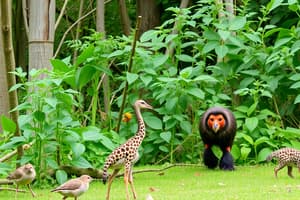Podcast
Questions and Answers
What does the principle of competitive exclusion state?
What does the principle of competitive exclusion state?
- Species can share resources without any competition.
- One species will always dominate in all niches.
- Competition occurs only when resources are abundant.
- Two species cannot occupy the same niche in the same habitat at the same time. (correct)
Which of the following relationships exemplifies mutualism?
Which of the following relationships exemplifies mutualism?
- Remoras feeding on scraps from sharks.
- Two species co-existing without interaction.
- A parasite living on a host and causing harm.
- Deer and birds where birds eat ticks off deer. (correct)
In what type of ecological interaction does one organism benefit while the other is unaffected?
In what type of ecological interaction does one organism benefit while the other is unaffected?
- Parasitism
- Commensalism (correct)
- Mutualism
- Competition
What characterizes predation in ecological interactions?
What characterizes predation in ecological interactions?
Which of the following statements is true regarding symbiotic relationships?
Which of the following statements is true regarding symbiotic relationships?
Flashcards are hidden until you start studying
Study Notes
Community Interactions
- Organisms within a biological community constantly interact.
- Interactions include competition for resources like food, shelter, and mates.
- Organisms may also have relationships where they depend on one another for survival.
Competition
- Organisms of the same or different species may compete for resources.
- Competitive Exclusion Principle: Two species cannot occupy the same niche in the same habitat at the same time.
Predation
- One organism (predator) captures and feeds on another (prey).
Symbiotic Relationships
- Two species living together in close proximity.
- Mutualism: Both species benefit from the relationship.
- Example: Deer and birds, where birds eat ticks and fleas off deer.
- Commensalism: One organism benefits while the other is unaffected.
- Example: Remoras and sharks, where remoras hitch a ride and feed on scraps of food.
- Parasitism: One organism (parasite) lives on or inside another (host) causing harm.
Studying That Suits You
Use AI to generate personalized quizzes and flashcards to suit your learning preferences.




